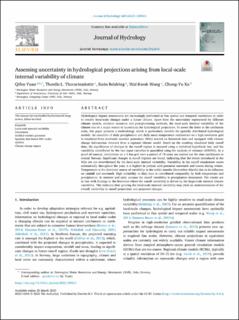| dc.contributor.author | Yuan, Qifen | |
| dc.contributor.author | Thorarinsdottir, Thordis L. | |
| dc.contributor.author | Beldring, Stein | |
| dc.contributor.author | Wong, Wai Kwok | |
| dc.contributor.author | Xu, Chong-Yu | |
| dc.date.accessioned | 2024-02-07T07:21:05Z | |
| dc.date.available | 2024-02-07T07:21:05Z | |
| dc.date.created | 2023-03-28T20:00:57Z | |
| dc.date.issued | 2023 | |
| dc.identifier.citation | Journal of Hydrology. 2023, 620 . | en_US |
| dc.identifier.issn | 0022-1694 | |
| dc.identifier.uri | https://hdl.handle.net/11250/3116043 | |
| dc.description.abstract | Hydrological impact assessments are increasingly performed at fine spatial and temporal resolutions in order to resolve local-scale changes under a future climate. Apart from the uncertainty represented by different climate models, emission scenarios and post-processing methods, the local-scale internal variability of the climate can be a major source of uncertainty for hydrological projections. To assess the latter at the catchment scale, this paper presents a methodology which is particularly suitable for spatially distributed hydrological models. An ensemble of daily precipitation and daily mean temperature realizations on a high-resolution grid is simulated from stochastic weather generators (WGs) trained on historical data and equipped with climate change information obtained from a regional climate model. Based on the resulting simulated daily runoff data, the significance of changes in the runoff regime is assessed using a statistical hypothesis test, and the variability contributed by the two input variables is quantified using the analysis of variance (ANOVA). As a proof of concept, simulations on a 1-km grid over a period of 19 years are carried out for nine catchments in central Norway. Significant changes in runoff regimes are found, indicating that the trends introduced in the WGs are not overwhelmed by the local-scale internal variability. Variability in the runoff simulations varies substantially throughout the year; it is highest in periods with potential snowmelt and lowest during winter. Temperature is the dominant source of variability in the colder months (November–March) due to its influence on rainfall and snowmelt. High variability in May–June is contributed comparably by both temperature and precipitation. In summer and early autumn the runoff variability is precipitation dominated. The results are in line with findings in the literature where the runoff variability is driven by the large-scale internal climate variability. This indicates that ignoring the local-scale internal variability may yield an underestimation of the overall variability in runoff projections and projected changes. | en_US |
| dc.description.abstract | Assessing uncertainty in hydrological projections arising from local-scale internal variability of climate | en_US |
| dc.language.iso | eng | en_US |
| dc.rights | Navngivelse-Ikkekommersiell-DelPåSammeVilkår 4.0 Internasjonal | * |
| dc.rights.uri | http://creativecommons.org/licenses/by-nc-sa/4.0/deed.no | * |
| dc.title | Assessing uncertainty in hydrological projections arising from local-scale internal variability of climate | en_US |
| dc.title.alternative | Assessing uncertainty in hydrological projections arising from local-scale internal variability of climate | en_US |
| dc.type | Journal article | en_US |
| dc.type | Peer reviewed | en_US |
| dc.description.version | publishedVersion | en_US |
| cristin.ispublished | true | |
| cristin.fulltext | original | |
| cristin.qualitycode | 2 | |
| dc.identifier.doi | 10.1016/j.jhydrol.2023.129415 | |
| dc.identifier.cristin | 2137769 | |
| dc.source.journal | Journal of Hydrology | en_US |
| dc.source.volume | 620 | en_US |
| dc.source.pagenumber | 13 | en_US |
| dc.relation.project | Norges forskningsråd: 255517 | en_US |

